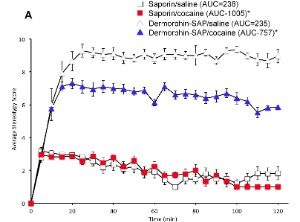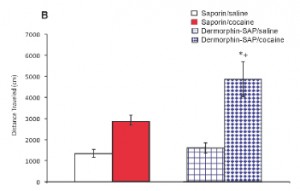by Kristen Ashley Horner and collaborators R. Murray and M.C. Logan
Mercer University School of Medicine, Savannah, GA 31404
Repeated exposure to psychostimulants, such as cocaine, can result in patterns of repetitive, inflexible behaviors, known as stereotypy.[1,2] These inflexible behaviors are thought to be similar to the type of behaviors observed with certain psychiatric disorders, such as Tourette syndrome and obsessive-compulsive disorder.[3] Stereotypic behavior has been associated with enhanced activation of the patch compartment of striatum, relative to the surrounding matrix compartment.[1,2] The striatum is a component of the basal ganglia that is important for the initiation of voluntary movement based on the appropriate environmental context. Enhanced activation of the limbic-associated patch compartment within the striatum may result in the perpetuation of behaviors that are driven by internal emotional states. This occurs at the expense of normal adaptive behavioral responses that may be mediated by the matrix compartment which surrounds the patch compartment.[1,3] The functional role of the patch compartment in the development of these types of behaviors has not been previously investigated. Thus, we sought to determine the contribution of the neurons of the patch compartment to the emergence of stereotypy induced by psychostimulant exposure, by lesioning the patch compartment with Dermorphin-SAP (Cat. #IT-12) prior to treatment with repeated, high doses of cocaine.
Fig. 1: Effects of intrastriatal infusion of Dermorphin-SAP (17 ng/ml) and repeated cocaine treatment (25 mg/kg), twice daily for one week followed by a week-long drug-free period, with a subsequent cocaine challenge (25 mg/kg) on stereotyped behavior (A) and locomotor activity (B). Values are expressed as the mean ±SEM. For stereotyped behavior the area under the curve (AUC values are in parentheses). Locomotor activity is expressed as the total distance traveled for the entire 2-hr obvservation period in centimeters. *Significantly different from respective control group, p<0.005 +Significantly different from saporin (vehicle)-pretreated cocaine-treated group, p<0.005.
Mu opioid receptors are densely expressed by the neurons of the patch compartment, while the neurons of the matrix compartment contain relatively few mu opioid receptors.[4,5] Thus, internalization of the Dermorphin-Saporin complex ultimately leads to the destruction of the mu opioid receptor-containing neurons of the patch compartment of striatum, while leaving non-mu opioid receptor-expressing neurons surrounding the patch compartment intact (Fig. 2). Animals were bilaterally-infused in the striatum with Dermorphin-SAP (17 ng/μl [6]) and allowed to recover for eight days. The animals were given daily injections of cocaine (25 mg/kg) or saline for one week, followed by a weeklong drug-free period.[7] Rats were then given a challenge dose of cocaine (25 mg/kg), placed in plexiglass chambers and the locomotor behavior was observed for 2h, followed by sacrifice. Stereotypic behaviors were rated on a scale from 1-10, with 10 representing the highest degree of the response [7-9]. Stereotypy scores were generated by averaging the scores from four behavioral dimensions: repetitiveness/flexibility (the number of alternative motor responses emitted), frequency (the number of responses per unit time), duration [the percentage of time spent performing the most dominant response(s)] and the spatial distribution of the motor response.[7,9] Horizontal activity was defined as the number of quadrants the animal crossed on a 4 x 4 grid, using AnyMaze software (Stoelting, Wood Dale, IL, USA) and converted into centimeters.[9] The degree of activation in the patch and matrix compartments was determined using c-Fos immunohistochemistry, which is considered a ubiquitous indicator of neuronal activation, and was coupled with calbindin immunohistochemistry to delineate the patch and matrix compartments.
Fig. 2: Effects of Dermorphin-SAP pretreatment on cocaine-induced immunoreactivity in the patch and matrix compartments of striatum. Photomicrographs showing calbindin immunoreactivity and c-Fos immunoreactivity in adjacent sections of the striatum, superimposed over the calbindin-labeled sections (A). Quantitative analysis of c-Fos immunoreactivity in the patch (B) and matrix (C) compartments of rats intrastriatally-infused with Saporin alone or Dermorphin-SAP (17 ng/µl), prior to repeated treatment with cocaine. Data are presented as the percent control of the number of c-Fos immunoreactive particles/mm2 in the patch and matrix compartments. *p<0 .05 vs. saporin-pretreated control animals +p<0.05 vs. saporin-pretreated cocaine-treated animals.
RESULTS: Dermorphin-SAP pretreatment significantly reduced the intensity of cocaine-induced stereotypy. Stereotypic behavior is also accompanied by a reduction in locomotor activity, and increased locomotor activity was seen in cocaine-treated animals that were pretreated with Dermorphin-SAP (Fig. 1). This pretreatment attenuated cocaine-induced c-Fos expression in the patch compartment, while enhancing cocaine-induced c-Fos expression in the matrix compartment (Fig. 2). The patch compartment is thought to mediate emotional and motivational aspects of behavior while the surrounding matrix compartment is important for processing externally-based sensorimotor information.[7] The current data show that animals that underwent patch compartment lesions prior to repeated cocaine exposure exhibited increased locomotor activity and diminished stereotypy and enhanced relative activation of matrix compartment. When the patch compartment is fully intact, a subsequent dose of cocaine may result in relatively greater activation of the patch-based circuits thereby masking the effects of the activation of matrix-based pathways, leading to greater levels of stereotypy as compared to locomotor activity. On the other hand, when the patch compartment is not fully functional, a subsequent dose of cocaine may tip the balance of activity in favor of the matrix compartment, leading to a greater degree of activation of the direct pathway, and increased locomotor activity, as compared to stereotypy. Together, these data indicate that that the patch compartment of striatum is necessary for repetitive behavior and is an important component of the basal ganglia circuitry that mediates repetitive behaviors, and suggest that when the activity of this region is enhanced as a result of repeated psychostimulant exposure, internally-driven motivational states may overrule ongoing adaptive behaviors, leading to focused stereotypy and perhaps, maladaptive habitual behaviors.
References
- Canales, J. J. & Graybiel, A. M. Nature Neuroscience 3, 377-383, doi:10.1038/73949 (2000).
- Horner, K. A., Hebbard, J. C., Logan, A. S., Vanchipurakel, G. A. & Gilbert, Y. E. J Neurochem 120, 779-794 (2012).
- Graybiel, A. M. & Rauch, S. L. Neuron 28, 343-347 (2000).
- Herkenham, M. & Pert, C. B. Nature 291, 415-418 (1981).
- Pert, C. B., Kuhar, M. & Snyder, S. H. Proc Natl Acad Sci USA 73, 3729-3733 (1976).
- Tokuno, H., Chiken, S., Kametani, K. & Moriizumi, T. Neurosci Lett 332, 5-8, doi:S0304394002008376 [pii] (2002).
- Canales, J. J. & Graybiel, A. M. Nat Neurosci 3, 377-383 (2000).
- Creese, I. & Iverson, S. D. Brain Res 55, 369-382 (1973).
- Murray, R. C., Gilbert, Y. E., Logan, A. S., Hebbard, J. C. & Horner, K. A. Brain Structure & Function 219, 1213-1229 (2014).





